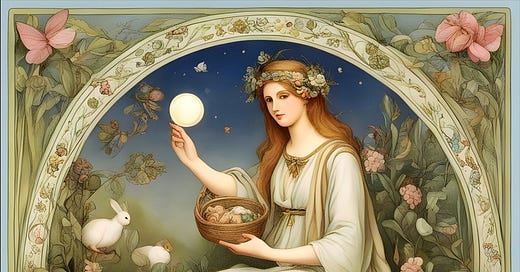Eostre, Ostara, or Easter?
The Germanic Goddess of Dawn, Spring, and Rebirth, Has a Long Evolution.
I remember being a kid, asking my father questions about Easter, like why in this celebration of Christ’s rebirth, is there an “Easter Bunny” that brought “Easter Eggs” and Easter Candy? His answer was simple, they both symbolize either spring, or rebirth. That satisfied me as a kid, and over time and having my own kids I decided to do my own research on the topic, simply for the desire for better answers both for my own curiosity, and for explaining it better to my sons. So here it is, the basic 101 history of Easter.
The Easter Question.
When my kids ask what rabbits and eggs have to do with Easter, I tell them that the answer ultimately lies with the Ancient European Goddesses of the Dawn and Spring. These once well worshipped and wide spread Goddesses like Eostre (Anglo Saxon), Ostara (Germanic), and Eos (Greek). When we see the modern imagery of Easter as a holiday, which is celebrated in the spring, and has been converted into a Christian celebration, it is no different than holidays like Yule / Christmas, and several others. But these spring goddesses and their symbolism and iconography directly relate to our modern celebration, in a way that no other Pagan holidays do.
Let's first run through a few similar goddesses throughout other areas of Europe and Asia, that have a Dawn, Spring, or Rebirth theme.
Aurora (Roman): The Roman goddess of dawn, Aurora’s name comes from the Latin aurora ("dawn"), which parallels the Germanic austrōn. She’s not a spring goddess per se, but her role as a light-bringer aligns with Ostara/Ēostre’s dawn imagery.
Eos (Greek): The Greek dawn goddess, Eos, is Aurora’s predecessor, and shares the same etymological thread. Known for her rosy fingers and daily renewal of light, she’s another parallel goddess with Eostre, though her myths focus more on romance and tragedy than seasonal change.
Hausos (Proto-Indo-European): Linguists and mythologists reconstruct a dawn goddess named Hausos (or Ausos) in Proto-Indo-European mythology, based on shared roots in Sanskrit (Ushas), Greek (Eos), and Germanic (austrōn). She’s a recently discovered ancestor to Ēostre and Ostara, embodying the primal concept of dawn as a life-giving force.
Historical authors like Jacob Grimm and the Venerable Bede, only wrote briefly of these Goddesses in their multitudes of writings, but as new archeology digs are happening, we are seeing that more idols, effigies, and areas of worship are popping up. Below is a piece depicting Eos circa 550 BC.

Historians know that humans decorating eggs at spring holidays predates Christ by thousands of years. This practice was done from Asia over to Western Europe, and multiple examples of them have surfaced at dig sites from one end of the continent to the other. In many parts of Europe, egg decorating took place before the widespread adoption of Christianity. It is unclear to what extent paganism and Christianity influenced the practice. The earliest example of egg decoration in Europe was a decorated egg found buried with a young girl in modern-day Worms, Germany, dating to the 5th century, when eggs were not yet associated with Easter.
In Northern England, the tradition of Pace Egging (derived from Latin pascha meaning 'Easter') involved boiling eggs in onion skins to dye their shells a golden colour, or alternatively covered in leaves or flowers inside an onion skin to leave a patterned imprint. The tradition is practiced on Easter but is thought to be pre-Christian in origin. Scandinavian traditions also involved boiling eggs with flowers inside onion skins to colour them.


Persian culture has a tradition of egg decorating, which takes place during the spring equinox. This time marks Nowruz, the Persian New Year. Family members decorate eggs together and place them in a bowl. It is said that it is from this cultural tradition that the Christian practice on Easter ultimately originates, having been transmitted via the Slavic peoples.
Honestly our history has been so censored and edited by the church, that the origins of anything and everything in Europe have been obscured. I do have faith that with more time and history being uncovered in modern day, the history of these things will become much more clear. Plus they will be shown to the world without the Vatican or Church of England having a say in the matter.
Conclusion :
Every year at Easter we see dozens of articles, memes, and other forms of messaging about Easter’s origins in Pagan Europe. This is without a doubt true, and has been verified and explained almost exhaustively.






Egg decorating in Europe was always a predominantly Slavic custom.